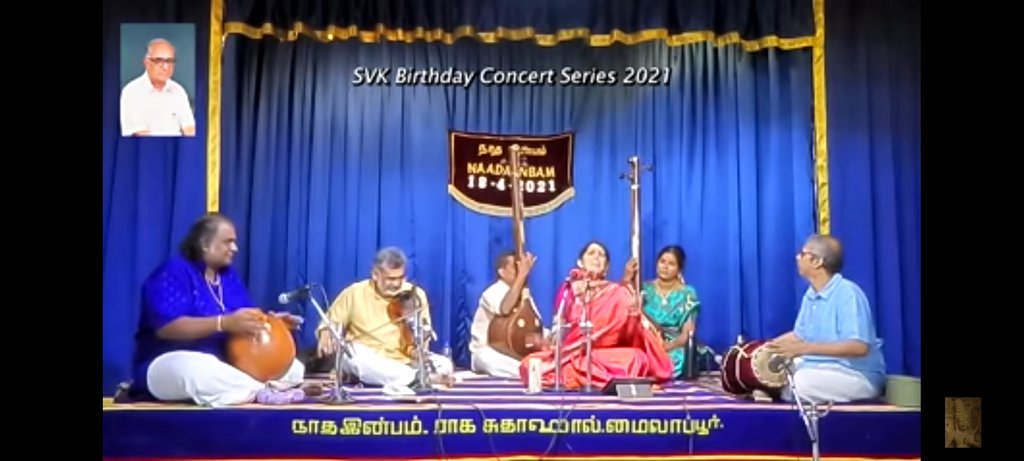Originally penned by Sri. Narayanan in his FB page and reproduced here

It would be a travesty if I said Amritha Murali performed a concert.
I should rather say she offered Atma nivEdanam at the feet of Divinity and raga dEvathas and the VaggEyakkaras who made it all happen. This kind of anubavam happens to me not more than 5-6 times in a full year of listening,when the theme is the artist's own innermost faith,verbal interventions are brief and from the heart and everything is sublimated to Music,yes,sublime music!
Amritha's theme was Bhakthi Bharatham,and her own faith in the theme was palpable from the word go.If bhakthi and bharatham are inseparable,so too are bhakthi and music. In fact, the dozen wonderful numbers Amritha sang were all woven reverentially by the Vaggeyakakaras,with bhakthi as the warp and music as the woof. Without bhakthi,there would have been no music,as all saints/vaggeyakkaras used music as a medium for practicing nava vida bhakthi (nine forms of bhakthi) for our salvation. Through full three hours of music of the highest quality, Amritha brought the theme home.
Bharatham? Yes,indeed,it all started in Kerala (Swati Tirunal’s vandE dEva dEva) and concluded in Amritsar (Thakur Tum Saranayi-Guru Nanak Shabad).
In between,Amritha’s guided pilgrimage took us through Tamil Nadu (the Trinity, Narayana Theertar,PeriyAzhwar,Gopalakrishna bharathi),Karnataka (Purandara Dasar) Andhra (Bhadrachalam Ramadasar,Annamayya), Maharashtra (Sant Tukaram Abhang),Kerala again (Adi Sankarar).
Finally,everyone came to realize it is all,Sarvam Brahma Mayam (Sadashiva Brahmendral).
Amrith carried this tour de force on the strength of her music,which has now become an amalgam of clarity,sensitivity,depth,sweep,svanubhava and vishranti. No rasikA can help being enveloped by the heady mix,and I am not complaining!
Briefly on the musical values.Early on,Lalita was a haunting exposition sans deviation (!),Dikshithar’s hiraNmayIm lakSmIm sadA bhajAm was a cadenced rendition,the niraval @ (san)gIta vAdya vinOdinIm continuing with the somber mood.
Next,Narayanathirtha’s Bhavaye Hridayaravinde in dEvagandhAri saw an inspired rendition at the
anupallavi line,dEva gandharvAdi brnda sEvita mAmava mukunda.wow,mAmava Mukunda!
Bhairavi main.Raga essay was a rare anubavam of traversing all the octaves in ten minutes. Bhadrachalam Ramadasar’s shloka from Dasarathi Satakam prefaced Annamayya’s Adi puruSa akhilAntarangA. A superb rendition followed by niraval @ bhava kamala mAdhavarApu-- completely soaked in raga rasam (couldn't help recalling KVN’s vinyasam@ MFAC in 80s).
Svaras in three kalams made it “the Main”!
Next was pure enchantment,Swamy Periazhwar’s pasurams..Manikkam Katti, as a rAgamalika in nIlambari, kamas, hamirkalyaNi,suraTTi,the ragas flowing seamlessly in 90 seconds each!
Length stands in the way of my writing about 5 more pieces which Amirtha generously served.
Except a word to say the delicious shades of KVN in Mukti alikkum in Senjurutti,thoroughly enjoyed!
H.K.Venkatram’s violin simply makes me crave for more! Sadly,we don’t hear him often enough here,do we?His dulcet sangathis in bEgadA,his honeyed essence of Bhiravi in under 7 minutes,his play for the Annamayya krithi,niraval and svaras,all marked him out as very special.Right through the 3 hours,he was equal to the rich repertoire and varied demands Amritha made on him.
K.Arunprakash Mridangam and Ghatam Dr.S.Karthick displayed unobtrusive but enriching support that is their hallmark. They were as much immersed as the rasikAs in the music and the narrative,yet intervened assertively at all needed places to keep up the tempo.I enjoyed their thani of brevity and intricate phrases moving on to a kOrvai of beauty and precision.
rAma bhakti sAmrAjyam EmAnavula kabbenO manasA! Yes,indeed.
